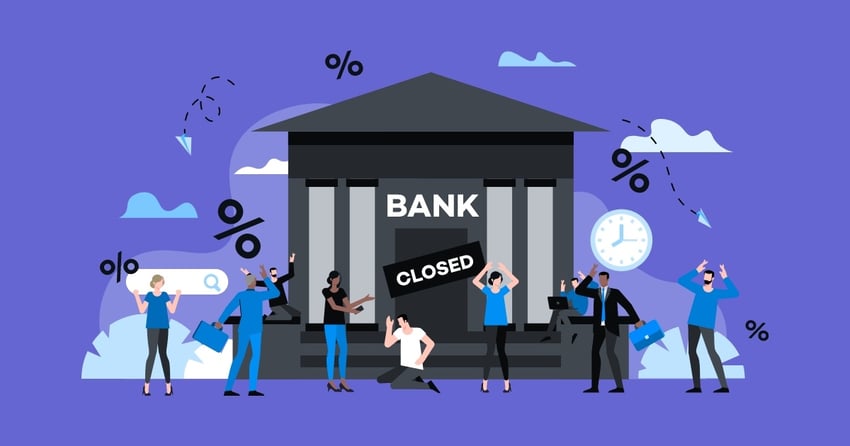Insight Into Your Vendor’s Banking Relationships and Understanding Their Operational Resiliency
By: Venminder Experts on March 14 2023
6 min read

As many of you may have seen, the pressures and issues that resulted from Silicon Valley Bank’s (“SVB”) failure have been constantly evolving and remain dynamic on an hour-to-hour and day-by-day basis.
For some of the most recent developments and helpful press releases, please refer to the following for additional information about the SVB situation:
- Silicon Valley Bank Receivership
- ICBA: Silicon Valley Bank and the Nation’s Largest Banks Are Not Community Banks
- California Financial Regulator Takes Possession of Silicon Valley Bank
- Joint Statement by Treasury, Federal Reserve, and FDIC
The Silicon Valley Bank Failure and Situation Summary
To summarize the situation beyond the evolving public disclosures, SVB was a top 20 U.S. banking institution that recently had operational and financial issues caused by management of its deposits received by customers and the investments it selected. At one point, SVB had nearly $200 billion of customer deposits.
Over time, SVB invested deposits into numerous long-term securities, such as mortgage bonds and treasury bonds, locking the bank into the rates on these long-term securities. As newer bond issuances resulted in rising yields, the securities that SVB held were less attractive and the bank did not implement other manners to offset the risk created from their investment portfolio to meet their operational requirements.
Eventually, SVB customers demanded deposits to meet their operational needs and SVB had to divest its long-term securities at losses, causing financial pressures seen in recent public disclosures and the eventual fall of the bank as customers raced to withdraw their funds from the bank.
This all resulted in the U.S. Federal Government and The Federal Deposit Insurance Corporation (“FDIC”) taking control of SVB and recently acting on Monday, March 13 to protect and fully guarantee all deposits from SVB customers. This press release explains it in more detail.
This was followed by the newly appointed CEO of SVB sending out a letter, stating that the U.S./domestic SVB bank under the control of FDIC is fully operational and operating as “business as usual” with its customers. You can further review of that letter to customers in this tweet.
Actions to Take in Your Vendor Risk Management Program Following the SVB Situation
While many organizations are operating under a “wait-and-see” mentality with daily new disclosures and updates found in the public domain regarding SVB and other bank vendors that may be under similar operational and financial pressures, your organization can take action to get ahead of protecting yourself of additional downsides from your vendor relationships and their banking relationships. With the protections and guarantees instituted by FDIC related to SVB in recent disclosures, the downsides to vendors/customers that utilize SVB have evolved and have seemingly been mitigated and limited in recent days.
However, your organization should use this learning opportunity related to the evolving SVB situation, and should take the appropriate steps to understand the lasting risks and impacts SVB and whatever other bank your vendor base may utilize. This will help protect your organization’s operational resiliency in this time of uncertainty and provide insight into the steps you can take to mitigate the risks that may arise.

Consider Implementing the Following Immediate Steps
- To understand the immediate and lasting risks that SVB and other banks under financial and operational pressure may pose to your vendor, you should first understand the exposure your vendor base has to SVB and generally all other banks (which can help mitigate for the next similar situation or bank failure).
- To do so in a streamlined, efficient manner, it is best to go directly to your accounting records/accounts payable department to see which vendors pay from an SVB account and/or other banking account to confirm which bank partner your vendors utilize.
- This is a surefire and immediate way to help expose which vendors may/may not have immediate, lasting risks tied to SVB and/or other banks.
- Start this exercise with your most critical vendors and work down the criticality list to get as much information that fits within your immediate vendor risk management program needs.
- To do so in a streamlined, efficient manner, it is best to go directly to your accounting records/accounts payable department to see which vendors pay from an SVB account and/or other banking account to confirm which bank partner your vendors utilize.
- If you are unable to determine if a vendor paying your organization utilizes SVB (or whichever banking relationship through your accounting/payment records), consider using Venminder’s Profile Sync functionality or Questionnaires functionality or even work to prepare and send a simple due diligence questionnaire yourself, inquiring about key information about a vendor’s banking relationship.
- If you are a Venminder customer, both Profile Sync and Questionnaire functionality can be done in the platform in a streamlined, comprehensive, and configurable fashion.
- Within Profile Sync, your organization can add a "banking relationship" field to the vendor profile and then send the vendor a profile sync request.
- Once this is captured in Profile Sync, your organization can refresh the banking relationship field on a regular cadence in the future.
- Profile sync helps with a potential next bank failure in the future; instead of relying on sending a questionnaire asking only a handful of specific banking relationship questions, the use of Profile Sync to ask a simple question to the vendor, such as "where do you bank" can preemptively capture this information for your organization’s full view into its vendor base.
- Use this opportunity to understand the vendor’s financial health and other risk exposure related to this type of future potential event, such as any risks associated with its business resiliency and disaster recovery.
- Venminder offers numerous purpose-built assessments to get a full picture of a vendor’s financial health, business continuity/resiliency and disaster recovery, and other domains that are impacted by failure of its banking relationships.
- Utilize adverse media monitoring, financial health monitoring, and other real-time monitoring tools to fill information gaps and keep your organization up-to-date with changes in your vendor’s risk profile with latest developments.
- Venminder offers Venmonitor™, a differentiated vendor risk screening and monitoring platform, as well as multiple ongoing monitoring tools through partners to help add visibility to your organization’s “blind spots” and streamline the information you need directly related to your vendor base and its risks related to evolving events, particularly related to banking relationships and potential future bank failures.
Simple Due Diligence Questionnaires to Consider and Utilize
Implementing a checklist and questionnaire in either your Venminder third-party risk management software platform or through your program can go a long way of understanding the lasting impact that the SVB situation has on your vendor base, and capture banking relationships preemptively across your vendor base to ensure you are operationally prepared and resilient in the future if another bank failure event occurs.
Sample Questions for Banking Partnership
- Who does your organization bank with?
- SVB specific question: Does your organization bank with SVB? Are you maintaining your deposits with SVB or have a plan to move them elsewhere?
- Does your organization hold all its funds/deposits with one bank or multiple institutions?
- What are the names of the institutions?
- What is your latest cash and cash equivalents balance and liquidity position?
- Outside of cash and cash equivalents, what are your sources of liquidity and funding, and how can you access them if you do not have access to cash?
- Are your funds/deposits held domestically in the U.S. or internationally?
- Have you recently performed any due diligence (i.e., financial health analysis / assessment) on your banking partner(s)?
- Do you have any restrictions on accessing your cash and cash equivalents balance?
- As a result of any bank failures or issues with your banking partner, do you anticipate any delays or difficulties in fulfilling your obligations to us or other customers?
This situation is understandably stressful for many organizations who may have vendors that are SVB clients. Consider taking a more proactive approach in asking your vendors about their potential exposure to SVB. Doing so will help you gain a bigger picture of your vendors' financial health and operational resiliency.
Related Posts
How the Real Estate Industry Can Mitigate Vendor Risk
Commercial real estate brokers face a significant concern when it comes to third-party...
The Benefits of Vendor Risk Profiling
Third-party risk management begins with assessing vendors and understanding their risks. Vendor...
How to Leverage Software to Gain Consistency in Vendor Risk Assessments
There’s a common challenge that can unify organizations of all sizes and industries – vendor risk...
Subscribe to Venminder
Get expert insights straight to your inbox.
Ready to Get Started?
Schedule a personalized solution demonstration to see if Venminder is a fit for you.




.gif?width=1920&name=Sample-Graphic-Animation%20(1).gif)



